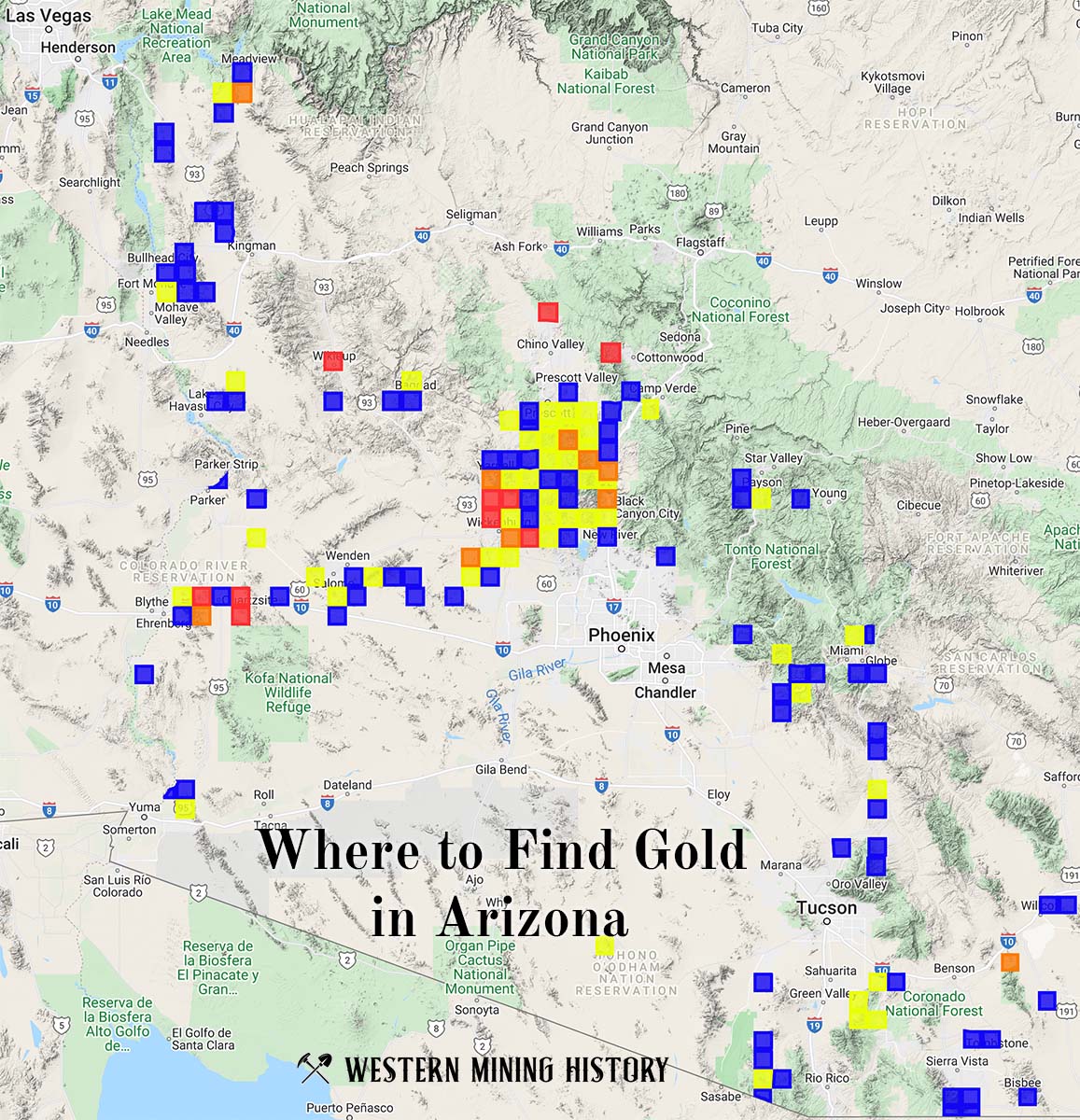The St. Louis Mine is a silver and lead mine located in Pima county, Arizona at an elevation of 5,495 feet.
About the MRDS Data:
All mine locations were obtained from the USGS Mineral Resources Data System. The locations and other information in this database have not been verified for accuracy. It should be assumed that all mines are on private property.
Mine Info
Elevation: 5,495 Feet (1,675 Meters)
Commodity: Silver, Lead
Lat, Long: 31.75889, -110.76361
Map: View on Google Maps
St. Louis Mine MRDS details
Site Name
Primary: St. Louis Mine
Secondary: Morningstar Mine
Commodity
Primary: Silver
Primary: Lead
Secondary: Gold
Secondary: Zinc
Secondary: Copper
Tertiary: Molybdenum
Tertiary: Iron
Location
State: Arizona
County: Pima
District: Greaterville District
Land Status
Land ownership: National Forest
Note: the land ownership field only identifies whether the area the mine is in is generally on public lands like Forest Service or BLM land, or if it is in an area that is generally private property. It does not definitively identify property status, nor does it indicate claim status or whether an area is open to prospecting. Always respect private property.
Administrative Organization: Coronado National Forest
Holdings
Not available
Workings
Type: Unknown
Ownership
Owner Name: Mr. Austin Mitchell
Home Office: Elgin, Il.
Years: 1969 -
Owner Name: Anaconda Co.
Years: 1969 -
Production
Year: 1966
Time Period: 1875 - 1966
Material type: ORE
Description: Cp_Grade: ^6 % Pb, 7 % Zn, 11 Oz Ag/Ton, 0.5 Oz Au/Ton, 1 % Cu
Deposit
Record Type: Site
Operation Category: Producer
Operation Type: Unknown
Discovery Year: 1874
Years of Production:
Organization:
Significant: N
Deposit Size: S
Physiography
General Physiographic Area: Intermontane Plateaus
Physiographic Province: Basin And Range Province
Physiographic Section: Sonoran Desert
Mineral Deposit Model
Not available
Orebody
Form: THIN, DISCONTINUOUS, SUBPARALLEL
Structure
Type: R
Description: Tilting And Broad Open Folds In S. And Extensive Faulting In N; Homoclinal
Type: L
Description: Attitude Of Veins Is Generally Conformable To Bedding N 50 - 60 E, 28 - 38 Se. Ne Trending Shear Zone
Alterations
Alteration Type: L
Alteration Text: Host Rock Altered And Metamorphosed To Hornfels And Skarn. Pyrite And Sericite.
Rocks
Name: Quartz Latite
Role: Associated
Age Type: Host Rock Unit
Age Young: Late Cretaceous
Name: Quartz Latite
Role: Associated
Age Type: Associated Rock
Age in Years: 56.000000+-2.000000
Age Young: Paleocene
Analytical Data
Not available
Materials
Ore: Covellite
Ore: Molybdenite
Ore: Gold
Ore: Chalcopyrite
Ore: Sphalerite
Ore: Malachite
Ore: Silver
Ore: Galena
Ore: Pyrite
Ore: Bornite
Comments
Comment (Deposit): MINERALS OCCUR AS FINE TO COARSE DISSEMINATED GRAINS AND AS AGGREGATES OF MIXED MINERALS IN BANDS AND CLUMPS. LEAD IS PRIMARILY IN THE VEIN AND VALUES INCREASE WITH DEPTH UNTIL THE 140 - FOOT LEVEL, WHERE IT DROPS APPRECIABLY. ZINC VALUES CORRESPOND WITH LEAD. CU VALUES DECLINE WITH DEPTH AND AWAY FROM THE VEIN. HIGH AG VALUES CORRELATE WITH HIGH VALUES OF PB AND ZN, CONCENTRATED ABOUT 90 - FOOT LEVEL. MO IS EVENLY DISTRIBUTED THROUGHOUT VEIN AND WALLROCK. GOLD APPEARS TO HAVE HIGHER VALUES NEAR SMALL FLEXURES WITHIN VEINLETS. OXIDIZED DOWN TO 20 - FOOT LEVEL.
Comment (Workings): 241 FOOT INCLINED SHAFT, DRIFTS, RAISE, SMALL STOPES AND DRIFTS.
Comment (Geology): AGE OF MINERALIZATION BELIEVED TO BE THAT OF QUARTZ LATITE INTRUSIVE OF DREWES - 1971.
Comment (Deposit): A GROUP OF APPROXIMATELY 10 CONTIGUOUS CLAIMS. ONLY OLD MINE IN THE DISTRICT TO BE ACTIVELY MAINTAINED AND HAS BEEN RECENTLY FURTHER DEVELOPED. JUDGED IN 1969 TO BE UNECONOMICAL TO MINE, DUE TO SMALL SIZE, TOO LOW GRADE, AND ERRATIC DISTRIBUTION OF ORE MINERALS. EXTENSIONS OF THE VEIN SYSTEM IN DEPTH AND LATERALLY, ARE NOT ENCOURAGING. POTENTIAL FOR A COPPER - MOLYBDENUM - BEARING PORPHYRY TYPE DEPOSIT, SHOULD NOT BE DISCOUNTED, THOUGH. ; INFO.SRC : 1 PUB LIT; 2 UNPUB REPT
Comment (Commodity): GOLD IS COMMON IN UPPER PART OF MINE, YET VERY ERRATICALLY.
Comment (Production): SPORADIC PRODUCTION FROM 1875 TO 1966.
References
Reference (Deposit): STEWART, J.C., 1971, GEOLOGY OF THE MORNINGSTAR MINE AREA, GREATERVILLE MINING DISTRICT, PIMA COUNTY, ARIZONA: UNIV. ARIZ., MS THESIS.
Reference (Deposit): SCHRADER, F.C., 1915, MINERAL DEPOSITS OF THE SANTA RITA AND PATAGONIA MOUNTAINS, ARIZONA: USGS BULLETIN 582, P.
Reference (Deposit): KEITH, S.B., 1974, INDEX OF MINING PROPERTIES IN PIMA COUNTY, ARIZONA: ARIZONA BUREAU OF MINES BULLETIN, 189, P. 121.
Reference (Deposit): DREWES, H., 1971, USGS MAP I - 613 (SAHUARITA QUAD)
Reference (Deposit): DREWES, H., 1970 , USGS BULLETIN 1312 - A.
Reference (Production): STEWART, J. C., 1969, P. 39 ; ABM BULLETIN 189, P. 121.
Arizona Gold

"Where to Find Gold in Arizona" looks at the density of modern placer mining claims along with historical gold mining locations and mining district descriptions to determine areas of high gold discovery potential in Arizona. Read more: Where to Find Gold in Arizona.